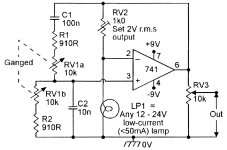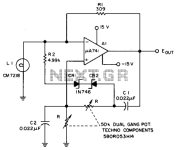Im reaching that age when you forget stuff.
Long story short. I was trying to build a test setup. And getting really crappy results.
Finally it dawned on me that that the real culprit was the crappy china made function generator.
Somebody mentioned this concept of building a function generator which had a light bulb. He mentioned that the idea / circuit had a patent. And pointed me to a youtube video where a young lady had built such a function generator.
This was years back.
Now all I can remember is you can built a simple high quality function generator using a light bulb. Google and searching cant find any info.
Anybody know anything about this concept or idea or patent ?.
Long story short. I was trying to build a test setup. And getting really crappy results.
Finally it dawned on me that that the real culprit was the crappy china made function generator.
Somebody mentioned this concept of building a function generator which had a light bulb. He mentioned that the idea / circuit had a patent. And pointed me to a youtube video where a young lady had built such a function generator.
This was years back.
Now all I can remember is you can built a simple high quality function generator using a light bulb. Google and searching cant find any info.
Anybody know anything about this concept or idea or patent ?.
It is probably a Wien-bridge sine generator, where the feedback loop contains a small lamp (6 V/50 mA or so, miniature lamp with wire legs). A comparator for turning sine to square, and an integrator for turning square to triangle might follow. A Wien-bridge oscillator generates low distortion sine in itself.
https://jet.hu/zar6005-rizsszem-izzo-6v50ma-feher-szinu-atlatszo-12174
https://jet.hu/zar6005-rizsszem-izzo-6v50ma-feher-szinu-atlatszo-12174
Real old school but it works, only problem is to get a very low current incandescent bulb.
60mA suggested above is WAY beyond what a plain OpAmp can supply.
Search for one using a FET as a gain controller.
60mA suggested above is WAY beyond what a plain OpAmp can supply.
Search for one using a FET as a gain controller.
good oscillators use R53 NTC thermistor etc, but since this are rare people try to use some sort of bulb....
The use of a light bulb in the feedback path of a Wein bridge oscillator was invented by Bill Hewlett in I believe 1939. The oscillator went on to become the 200A which was Hewlett Packard's first product.
+1A precision regulator can be built from op-amps, diodes, a RC low-pass filter, and JFETs.
Though getting good performance, i.e., fast settling, low noise, and low THD is a challenge. Victor's Oscillator is a good place to start.
Alternatively, have a look at state variable oscillators such as that used in the HP 8903A/B.
Tom
It is a tradeoff: for low THD, one has to wait a long time for the oscillator to stabilize.tomchr said:Though getting good performance, i.e., fast settling, low noise, and low THD is a challenge. Victor's Oscillator is a good place to start.
Ed
All low-distortion sine-wave oscillators are stabilized by a slow feedback loop consisting of an amplitude detector, low-pass filter, and a means to adjust the oscillator's gain or phase.
The slow feedback loop must act slowly because it is causing distortion!
I notice that ultra-low distortion oscillators tend to be fixed-frequency. A long time ago, I designed a variable-frequency oscillator. I can see it settle after I turn the knobs. 🙂
Ed
The slow feedback loop must act slowly because it is causing distortion!
I notice that ultra-low distortion oscillators tend to be fixed-frequency. A long time ago, I designed a variable-frequency oscillator. I can see it settle after I turn the knobs. 🙂
Ed
While not the absolute best available, the HP 239A is a very nice AF oscillator and is fairly inexpensive if you can find one.
Specs:
Distortion (>600R Load, < 3 V Output):
10 Hz to 20 kHz: < -95 dB (0.0018%) THD
20 kHz to 30 kHz: < - 85 dB (0.0056%) THD
30 kHz to 50 kHz: < - 80 dB (0.01 %) THD
50 kHz to 110 kHz: < - 70 dB (0.032%) THD
Specs:
Distortion (>600R Load, < 3 V Output):
10 Hz to 20 kHz: < -95 dB (0.0018%) THD
20 kHz to 30 kHz: < - 85 dB (0.0056%) THD
30 kHz to 50 kHz: < - 80 dB (0.01 %) THD
50 kHz to 110 kHz: < - 70 dB (0.032%) THD
The resistance vs. filament temp characteristic of the bulb is used to stabilize the Wien bridge generator voltage so that it does not go into clipping.It is probably a Wien-bridge sine generator, where the feedback loop contains a small lamp (6 V/50 mA or so, miniature lamp with wire legs). A comparator for turning sine to square, and an integrator for turning square to triangle might follow. A Wien-bridge oscillator generates low distortion sine in itself.
https://jet.hu/zar6005-rizsszem-izzo-6v50ma-feher-szinu-atlatszo-12174
I've been using small lamps which I think (cannot remember exact) are 28V types and low current. The cold resistance is 75 and 120ohms for the two types I bought 10each of. Got them from digikey. .
Try here:
https://www.digikey.no/en/products/filter/incandescent-neon-lamps/101?s=N4IgjCBcoCxaBjKAzAhgGwM4FMA0IB7KAbRBgCYwBWADgnwupvJAcpgGYWBdfABwAuUEAGUBAJwCWAOwDmIAL74AbB3ggkkNFjyESIGgHZDYGqxABOQzAAMa-GDDKqNi+ae1lPfkMiiJMvJK4DRq0BooGDj4RJCkHLQcHMogvCCCwmJScor4ALQs4ZoSAK66saRUqQo1QA
I am pretty sure I selected the ones with 25k hours life.
Anyways, this type of oscillator works pretty good. You need gain of 3x. I use the 75ohm version in my latest, the feedback is a 133ohm in series with a 200ohm pot which has a 100ohm resistor in parallel. This gives an easy adjustment. For this one I needed a low THD sine at 300kHz, and when adjusted it hits about -106dB THD and has peaked at -109dB. This using an LTC6228 opamp. I have a 10ohm resistor in series with the lamp, haven't had time to test if that has an effect, my idea was a little pure resistance might make the lamp side of the network less 'twitchy' or sensitive. I dunno, need to experiment.
Oh be sure to have a small dab of bluetack on the lamp because else they are microphonic as hell. The bluetack cure that 100%.
Edit: listed wrong opamp... corrected now
Try here:
https://www.digikey.no/en/products/filter/incandescent-neon-lamps/101?s=N4IgjCBcoCxaBjKAzAhgGwM4FMA0IB7KAbRBgCYwBWADgnwupvJAcpgGYWBdfABwAuUEAGUBAJwCWAOwDmIAL74AbB3ggkkNFjyESIGgHZDYGqxABOQzAAMa-GDDKqNi+ae1lPfkMiiJMvJK4DRq0BooGDj4RJCkHLQcHMogvCCCwmJScor4ALQs4ZoSAK66saRUqQo1QA
I am pretty sure I selected the ones with 25k hours life.
Anyways, this type of oscillator works pretty good. You need gain of 3x. I use the 75ohm version in my latest, the feedback is a 133ohm in series with a 200ohm pot which has a 100ohm resistor in parallel. This gives an easy adjustment. For this one I needed a low THD sine at 300kHz, and when adjusted it hits about -106dB THD and has peaked at -109dB. This using an LTC6228 opamp. I have a 10ohm resistor in series with the lamp, haven't had time to test if that has an effect, my idea was a little pure resistance might make the lamp side of the network less 'twitchy' or sensitive. I dunno, need to experiment.
Oh be sure to have a small dab of bluetack on the lamp because else they are microphonic as hell. The bluetack cure that 100%.
Edit: listed wrong opamp... corrected now
Last edited:
Yeah my point was if someone wants to get the same lamp since these obviously work well. There seems to be issues regarding which lamps to use.
The reason I selected those was they pretty much cost the same as those rated for less hours so why not?
The reason I selected those was they pretty much cost the same as those rated for less hours so why not?
The lamp(s) chosen will affect the stability and the distortion of the oscillator. It is a balancing act to ensure that the resistance of the lamp changes with increasing feedback current but also that is does not get hot enough to increase the dissipation rate as this will lead to greatly increased distortion at low frequencies. The solution often found in later iterations of HP's oscillators is to use two or three bulbs in series. It should be noted that these bulbs were carefully chosen for their delta-R over temperature and were usually binned for these characteristics. In other words, just any old lamp won't necessarily work well and enable very low distortion.
Bill Hewlett's master thesis as well as articles in several of the early HP Journals go into quite a bit of detail on the theory and application of the incandescent bulbs in the feedback loop.
Bill Hewlett's master thesis as well as articles in several of the early HP Journals go into quite a bit of detail on the theory and application of the incandescent bulbs in the feedback loop.
I'd bet good money that trying to build and sort out a new, reliable Wien bridge oscillator is more work than just fixing whatever is wrong with your commercial function generator.
- Home
- General Interest
- Everything Else
- Function Generator with light bulb



